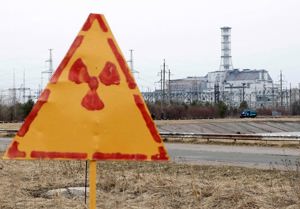Chornobyl to undergo “green” experiment
Environmentalists oppose plans to grow biomass in the exclusion zone and demand auditing of radiation-affected areas
The State Agency for Exclusion Zone Management and the Ukrainian-Belgian joint venture PhytoFuels Investments are going to carry out an experiment to use the Chornobyl exclusion zone to grow biomass that can be used for “green” energy generation.
“We would like to conduct the main field research within a year (before the end of March 2012 – Author),” the state agency’s deputy head Mykola Proskura says. It is planned to grow switch grass (a perennial plant that does not need to be re-sown) which produces biomass that can be burnt at thermal power stations or used as a source of biogas. According to Proskura, the combustion releases pure energy, while the radionuclide-containing ashes will be cemented and kept at a special storage facility in the Chornobyl Power Plant’s exclusion zone. The official claims that special combustion technologies and filters can in fact reduce to zero the radioactive emissions into the environment. This will make it possible not only to get energy but also more effectively decontaminate the affected soil and plants.
There have already been precedents of treating radiation-polluted areas in the world. “For example, Belarus is reusing a third of the radiation-contaminated lands after carrying out expensive decontamination programs. An estimated 50 percent of the contaminated land in the 260,000-ha exclusion zone can be used for growing energy crops. This could in turn produce 200 MW of electricity, to be supplied to 400,000 households or, in terms of combined production of electric power and heat, this is comparable with the output of one unit of a small nuclear power plant (500 MW),” says a European-Ukrainian Energy Agency (EUEA) press release on the prospects of “green” power generation in the Chornobyl area.
Speaking of the implementation of this project, its authors admit that it will meet just a fraction of Ukraine’s energy needs. “We cannot reject nuclear energy — we have neither the technological nor financial resources to do so. Nuclear energy currently accounts for about 13 percent of the country’s overall energy balance and approximately 48 percent as far as electricity is concerned. Yet the exclusion zone provides a chance to take bold steps towards a ‘greener’ and ecologically sustainable future,” says Dave Young, chairman of the EUEA board and general manager of INS, a company that specializes in alternative energy projects.
“Using half of the zones to grow energy plants will produce an energy-related equivalent of 0.8 billion cubic meters of gas. Of course, this will not solve the energy problems of Ukraine, which imports 33 billion cubic meters of gas. Still, it is more than most of green projects produce (about 200 MW of electricity and up to 300 MW of heat). The point is that the exclusion zone’s soil cannot be used for other (especially food-producing) purposes, because it is too radioactive and too expensive to decontaminate,” says Loic Lerminiaux, cofounder of PhytoFuels.
Seeking alternative sources of energy in the exclusion zone could help infuse money into the local economy and create new jobs. At the same time, this can help solve the problem of fire control in the polluted woods by using these installations to burn dry trees that are highly inflammable in the summer.
Tetiana Tymochko, chairperson of the All-Ukrainian Ecological League, categorically opposes all kinds of “green” experiments in the exclusion zone. “They (the government and the agency – Author) are toying with the idea of growing these plants in the exclusion zone for four years now. We take a dim view of these intentions,” she told The Day. In her opinion, using any territory in the exclusion zone should be preceded with ecological certification and serious research into the condition of this land. According to Tymochko, an ecological audit and certification will show the real condition of the Chornobyl area, because nobody knows how contaminated the territories around the plant are at present.
However, she believes that even if this research is done, it will be better not to grow anything. “Radiation-affected lands must not be used for anything at all,” Tymochko says. Firstly, the people working there will be exposed to radioactive contamination, which will have a direct negative effect on their health. Besides, the plants grown in the affected soil are bound to remain contaminated, the ecologist explains. Tymochko insists that there are no technologies today which completely prevent the release of radioactive particles into the air when plants of this kind are being burned.






